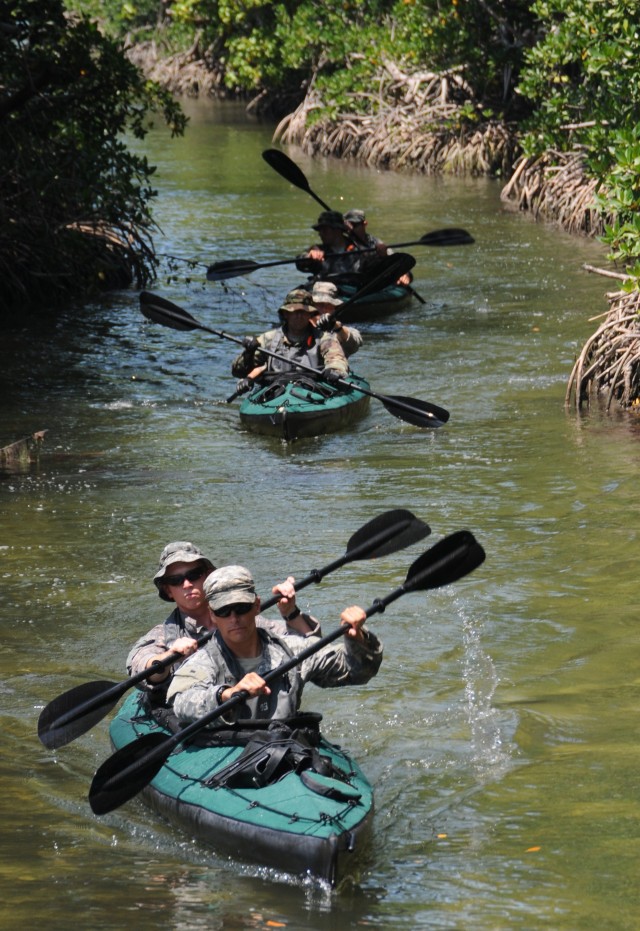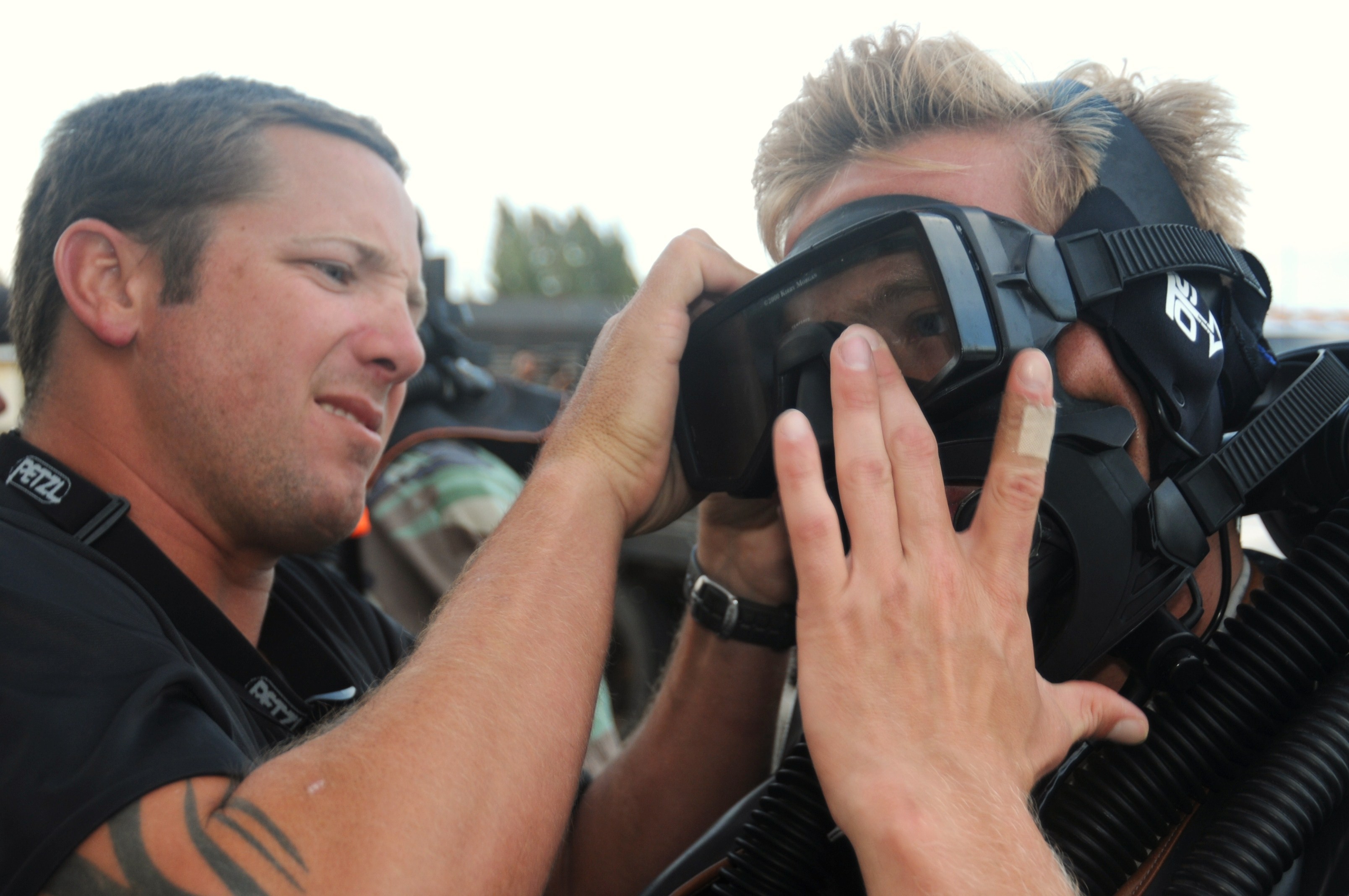On the southern tip of the Florida Keys, at what was a fallout shelter during the Cuban Missile Crisis era, is the Special Forces Underwater Operations School. It's where the military's elite special-operations forces train at some of the most physically demanding courses in the Army: the Combat Diver Qualification, Combat Diving Supervisor and Diving Medical Technician courses. Soldiers of Company C, 2nd Battalion, 1st Special Forces Training Group, run the school as part of Fort Bragg's U.S. Army John F. Kennedy Special Warfare Center and School.
During the six-week qualification course, Special Forces Soldiers learn more than basic scuba diving-they learn a new method of transportation. Master Sgt. J.T. Reed, the operations sergeant for the school, said the schoolhouse focuses on more than the skill of diving; it also focuses on the overall spectrum of waterborne operations, to include tactical infiltration and search and recovery operations.
"To us, it's just another way of getting to work," Reed said. "Some teams can jump into an area using HALO (high-altitude, low-opening airborne operations); our teams use a variety of methods in the water to come in undetected. That gives the operational force a full set of capabilities."
Prior to reporting to Key West, candidates first complete a pre-scuba course with their own units to prepare them for the tasks they'll have to complete the first week at dive school.
Staff Sgt. Samuel Winslow, a dive school candidate from Norridge Wock, Maine, said the three-week train-up was essential for him to be ready for the intensity of this course.
"For me, one of the hardest things was the underwater swim test," Winslow said. "You build up your lung capacity, but it just comes down to being confident. You have to say, 'I know I can do this!'"
For others, even after the pre-scuba course, CDQC was still one of the greatest challenges they've faced in their Special Forces training.
Sergeant Matthew Ruhnke, from Hattiesburg, Miss., said between the train-up and his off-time training, he would spend hours a week swimming prior to arriving at Key West.
"We had to do the pre-scuba class, so we knew what to expect," Ruhnke said. "However, that didn't make it any less hard."
The dive course begins with pool week, where individuals are evaluated on their ability to complete rigorous water testing to include: a 50-meter underwater swim, a 500-meter open water swim in uniform, as well as stress tests, where candidates are bound at the hands and feet and required to perform tasks in the water. This stress is the most effective way to gauge a diver's ability to remain calm while under pressure and underwater.
"It's vital for them to not lose their cool when something goes wrong," Reed said. "We put as much pressure as possible here, so they are prepared out there.
"The ocean does not care, it will kill you."
Once the candidates show their proficiency in the water, they move on to learn advanced military scuba-diving techniques. Scuba is the acronym for a self-contained underwater breathing apparatus, and candidates at the dive school learn to use both open- and closed-circuit dive systems. Open-circuit systems allow a diver to breathe through a tank, while a closed-circuit system recycles the diver's air through a rebreather.
Students also gain experience in search and recovery operations and deep-sea diving. After the first week, the dive candidates break into teams and focus on operational missions techniques, such as underwater navigation. They also learn to use diver propulsion systems-submersible vehicles that move two divers and their equipment quickly and quietly through the water.
It is the time saved by having students attend pre-scuba courses that enables then students to get this advanced training, according to Reed.
Sergeant Michael Crotte, a dive school candidate from Redding, Calif., said he was glad the school returned to that requirement.
"Not all of the classes before us had time for all of this advanced training," Crotte said. "Between the diver propulsion devices, airborne operations and helo-casting, I feel like our class was trained in the best techniques out there."
The final week of CDQC teaches the candidates tactical application of their skills. They conduct a water navigation course in portable kayaks, custom built for the school. This provides combat divers a quick and quiet way to travel without having to worry about mechanical problems.
The candidates also navigate open waters in a combat raiding rubber craft. These specialized watercrafts are made custom for special-operation forces, so that they are easily broken down and easily deployable. The students also use the CRRC to conduct beach landing site assaults.
One of the final training exercises is performing an airborne operation into the open water. There are added risks when jumping into the water, as jumpers can be trapped in the parachute harness, or may have trouble escaping the parachute canopy. Each jumper is trained extensively on how to safely release the harness and swim upstream from the canopy prior to making the jump.
After the students complete their water jump, they begin planning for their final culmination exercise, where they incorporate their six weeks of training into one complex training mission. Each team spends the day planning their route, while considering factors such as wind speeds, tide levels and their rate of oxygen usage while diving. As the sun sets, the teams don their scuba equipment and embark on their rafts to boat, dive and swim to their final targets.
Throughout the night, the students spend hours navigating the dark Key West waters. They combine their lessons in diving, open-water swimming and tactical boating, to quietly infiltrate a shoreline on their way to their final objective: securing sensitive materials from an enemy safe-house.
The night enhances the uncertainty of what resistance the team will encounter as they assault the isolated building in the woods. All is clear and quiet as the team approaches to breach the door.
POP. POP. POP.
The team is ambushed by "enemy-fire"-opposition forces with paint ball guns. Despite the barrage of "bullets," the team secures the sensitive material, and quickly escapes the objective.
They slip through the woods and return to their boats, finally completing their last training exercise to become combat divers.
Upon earning their Combat Diver Qualification Badge, these Special Forces Soldiers will return to their units as part of a dive team, and enhance the special operations community with one more way to get to work.
Staff Sgt. Marshall Pesta is the public affairs noncommissioned officer in charge at the U.S. Army John F. Kennedy Special Warfare Center and School at Fort Bragg, N.C.






Social Sharing